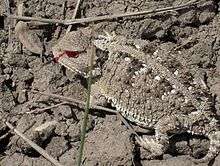Autohaemorrhaging
Autohaemorrhaging, or reflex bleeding, is the action of animals deliberately ejecting blood from their bodies. Autohaemorrhaging has been observed as occurring in two variations.[1] In the first form, blood is squirted toward a predator. The blood of these animals usually contains toxic compounds, making the behaviour an effective chemical defence mechanism. In the second form, blood is not squirted, but is slowly emitted from the animal's body. This form appears to serve a deterrent effect, and is used by animals whose blood does not seem to be toxic.[1] Most animals that autohaemorrhage are insects, but some reptiles also display this behaviour.[2]
Some organisms have shown an ability to tailor their autohaemorrhaging response. Armoured crickets will projectile autohaemorrhage over longer distances when attacked from the side, compared to being attacked from an overhead predator.[3]
Insects
Five orders of insects have been observed to utilize this defence mechanism.
- Beetles
- Meloidae (blister beetles) – their haemolymph contains cantharidin that they sequester from plants on which they feed.
- Timarcha species
- Chrysomelidae – their haemolymph contains anthraquinones.
- Coccinellidae (ladybird, ladybug or lady beetles) – An alkaloid toxin is exuded through the joints of the exoskeleton, triggered by mechanical stimulation (such as predator attack).[4]
- Hemiptera
- Cercopidae – including spittlebugs Prosapia bicincta and Prosapia ignipectus[5]
- Hymenoptera
- Sawfly larvae
- Orthoptera
- Bushhoppers, such as Dictyophorus spumans, Phymateus viridipes and Phymateus leprosus – their haemolymph contains cardiac glycosides, sequestered from milkweed on which they feed.
- Katydids, including Eugaster species
- Armoured ground crickets
- Enyaliopsis nyala
- Plecoptera
- Stonefly larvae
Reptiles

Lizards
- Horned lizards (Phrynosomatidae).[6] At least eight species of horned lizards are able to squirt an aimed stream of blood from the corners of their eyes, up to 5 feet (1.5 m).
Snakes
- West Indian wood snake, Tropidophis (a genus of dwarf boa), which expels blood from the mouth, nostrils and eyes when disturbed.
- European grass snake, Natrix natrix (a colubrid) which secretes blood from the mouth and nose while playing dead.
- Long-nosed snake, Rhinocheilus lecontei, is the only snake reported to expel blood from the cloaca.[6]
Consequences of reflexive bleeding
In some cases, the loss of blood can be substantial. Beetles may lose up to 13% of their net body weight as a consequence of expelling haemolymph.[7] Autohaemorrhaging may result in dehydration. The ejection of blood puts organisms at risk of cannibalism from conspecifics.[8]
.jpg)
See also
- Autothysis
- Haemorrhage
References
- Iftime, Alexandru; Iftime, Oana (January 2014). "Thanatosis and autohaemorrhaging in the Aesculapian Snake Zamenis". Herpetozoa. 26 (3–4): 173–174 – via Zobodat.
- Bateman, P. W.; Fleming, P. A. (2009). "There will be blood: autohaemorrhage behaviour as part of the defence repertoire of an insect". Journal of Zoology. 278 (4): 342–348. doi:10.1111/j.1469-7998.2009.00582.x. ISSN 1469-7998.
- Bateman, Philip W.; Fleming, Patricia A. (2012-04-26). "Signaling or Not-Signaling: Variation in Vulnerability and Defense Tactics of Armored Ground Crickets (Acanthoplus Speiseri: Orthoptera, Tettigoniidae, Hetrodinae)". Journal of Insect Behavior. 26 (1): 14–22. doi:10.1007/s10905-012-9329-5. ISSN 0892-7553.
- The Alkaloids: chemistry and physiology, Volume 31 By Arnold Brossi
- Thompson, Vinton; Carvalho, Gervasio S. (2016). "Abrupt Geographical Transition between Aposematic Color Forms in the Spittlebug Prosapia ignipectus(Fitch) (Hemiptera: Cercopidae)". Psyche: A Journal of Entomology. 2016: 1–10. doi:10.1155/2016/3623092.
- Iturriaga, Manuel (May 2014). "Autohemorrhaging behavior in the Cuban Dwarf Boa Tropidophis melanurus Schlegel, 1837". Herpetology Notes. 7: 339–341 – via Research Gate.
- Klowden, Marc J. (October 2007). Physiological Systems in Insects. 2. Elsevier. p. 369. doi:10.1016/c2011-0-04120-0. ISBN 9780124158191.
- Bateman, Philip W.; Fleming, Patricia A. (2012-04-26). "Signaling or Not-Signaling: Variation in Vulnerability and Defense Tactics of Armored Ground Crickets (Acanthoplus Speiseri: Orthoptera, Tettigoniidae, Hetrodinae)". Journal of Insect Behavior. 26 (1): 14–22. doi:10.1007/s10905-012-9329-5. ISSN 0892-7553.
External links
